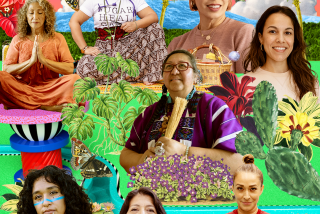Bringing Medicine From the Village Into the Public Eye
- Share via
ALBUQUERQUE — Pungent white incense wisps into the air from an earthen burner as Maria de Lourdez Gonzales Avila begins a cleansing ceremony with her students. Gently blowing the perfumed smoke on their heads, arms, legs and into their mouths, Avila aims to purify the students’ minds and bodies from negative energies.
Avila is a Mexican curandera, or healer, invited by the University of New Mexico to participate in a two-week course on the practice of indigenous folk medicine, also known as curanderismo, in Mexico and other Latin American countries.
A steady stream of Latino immigrants is fueling the demand for curanderismo in the Southwest. Often misunderstood as witchcraft, the practice also has piqued the interest of doctors trying to educate themselves about different ways to approach medicine and healing.
Curanderismo is a holistic, spiritual approach to medicine that uses the natural world to heal the mind, body and soul. Curanderas often prepare teas, creams and tinctures from herbs and plants, and use massage therapies to treat a wide variety of ailments.
“Mexicans and Hispanics have been doing this type of medicine for centuries,” said Eliseo “Cheo” Torres, university vice president for student affairs who started the course. “[Curanderismo] is a mixture of knowledge and ritual and indigenous medicine. Not only is it a healing practice, it is a source of pride for Latinos. It is part of our culture.”
Beyond creating plant-derived remedies, curanderas are revered in the Latino culture as people with a gift of healing and supernatural intuition. Marco Antonio Campos Romeu, a curandero from Mexico City, will treat a baby’s earache with a drop of hand-mashed garlic oil or recommend a cup of cascara sagrada tea for a patient with digestive problems.
But for psychological ailments such as post-traumatic stress, anxiety or depression, Romeu might try a combination of treatments such as incense, massage, candle rituals and sweat cleansing ceremonies.
“I don’t make magic potions or anything like that. I treat people with la vida de las plantas [the life of plants] and the forces of life,” Romeu said.
One of the major appeals of curanderismo and folk medicine in general is that it’s cheap and accessible, especially for people in rural areas.
Elva Heredia is founder and president of New Mexico Promotoras Al Alcance, an organization that works with the Latino migrant community in Albuquerque to explain the U.S. healthcare system and services. She said many immigrants cannot afford to use Western medicine. “There are more and more and more migrant people every year that come here and don’t have insurance or money,” she said.
Heredia attended the university’s curanderismo course so that she could learn what natural remedies are effective for minor health issues.
“[Curanderismo] emphasizes for people to start at home with their health, especially for those who cannot afford the high costs of healthcare or hospitalization,” Heredia said. “Our services reinforce to migrants that they can still practice what they are used to, their remedios [remedies], but other services are available if needed.”
Curanderismo is also finding a new audience with people disillusioned with traditional Western medicine, opting instead for a more natural, personal and affordable form of treatment.
As a registered nurse for more than 30 years, Lydia Lopez Vandiver was once skeptical of alternative medicine. Now a doctor of Oriental medicine as well as a nurse, Vandiver said she realizes that traditional medicine focuses on treating only the physical aspect of a person, and excludes mind and spirit from the healing process.
“In Western medicine, when you go for an appointment, the doctor talks to you for a couple minutes and then gives you a pill. It’s fast and incomplete,” Vandiver said. “There’s no connecting with the spirit, no touching or really talking to a patient. I do believe in Western medicine, but there are a lot of things we should integrate.”
To promote the use of curanderismo as integrative medicine, Torres is working with Arturo Ornelas of the University of Morelos in Cuernavaca, Mexico, to bring a curanderismo training program to the University of New Mexico next year. The program will incorporate aspects of both traditional medical practices and folk medicine.
Ornelas coordinates a certificate program at the Cuernavaca institute that trains curanderas with physicians for three years. The training includes modern medical techniques and medical research, as well as networking sessions with other folk healers. Ornelas said the goal is to bring legitimacy to the curanderismo’s role, and combine the positive aspects of Western and folk medicine.
Yet as the interest in folk medicine grows, some medical professionals are becoming increasingly concerned that people who seek treatment from folk healers aren’t getting proper care.
Ben Daitz, doctor and professor emeritus at the University of New Mexico’s Department of Community Medicine who has treated patients who also seek the help of curanderas, said people should use caution with folk medicine as they do with other major health decisions.
“We have to be aware of the limits of curanderismo because there is no evidence to show that treatments are effective, and people can be misled,” Daitz said. “I worry that people who have diseases like diabetes, hypertension and arthritis are not taking proper steps to ensure proper treatment.”


